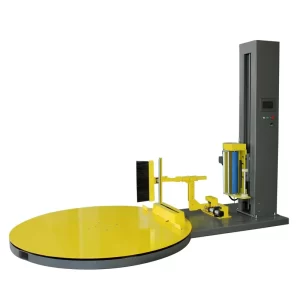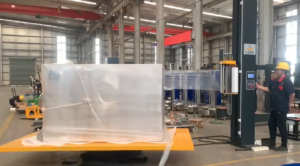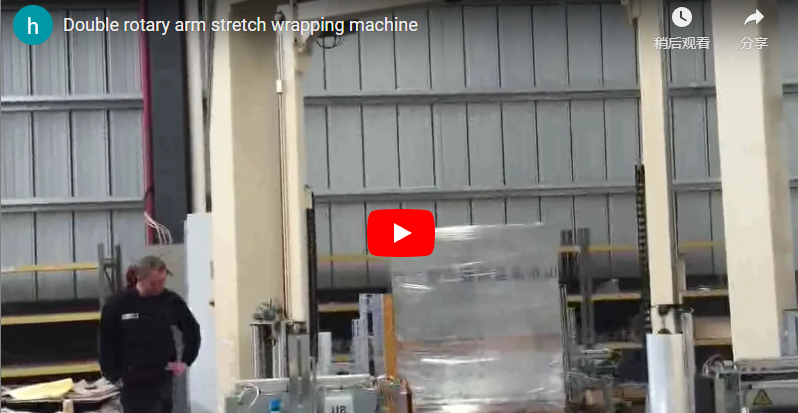Mastering Oversized Loads: A Technical Deep Dive into Rotary Arm Pallet Wrapping Machines
Handling and securing exceptionally large, heavy, or unstable palletized loads presents unique challenges in manufacturing, warehousing, and logistics. Standard turntable stretch wrappers often fall short when dealing with these dimensions or weight limitations. This is where the rotary arm pallet wrapping machine emerges as a highly effective and robust solution, designed specifically for securing super-sized or difficult-to-wrap pallets quickly, efficiently, and safely.
These machines are indispensable assets in facilities handling products like large machinery components, building materials, furniture, or assembled goods that exceed typical pallet parameters.
1. Understanding the Rotary Arm Concept
Unlike traditional turntable wrappers where the pallet rotates on a platform, a rotary arm stretch wrapper keeps the pallet stationary. A robust arm, equipped with the film delivery system, rotates around the static load. This fundamental design difference offers significant advantages:
- Load Stability: Ideal for very heavy, tall, or unstable loads that could shift or topple on a rotating platform.
- Unlimited Weight Capacity: Since the load sits directly on the floor or a conveyor, the machine itself doesn't bear the pallet's weight, removing typical weight restrictions.
- Integration Flexibility: Easily integrates into automated conveyor lines where stopping a pallet for wrapping is preferable to transferring it onto a turntable.
2. Key Design & Structural Components
The effectiveness of a rotary arm wrapper stems from its well-engineered components:
- Rotary Arm: A structurally sound arm, typically constructed from heavy-gauge steel, designed to rotate smoothly and consistently around the load while carrying the film carriage. Drive mechanisms often involve robust ring gears or chain systems.
- Support Structure (Mast/Gantry): A heavy-duty steel frame (either floor-mounted mast or overhead gantry style) that supports the rotating arm assembly and guides the vertical movement of the film carriage to ensure even wrapping from top to bottom.
- Film Delivery System (Film Carriage): This is the heart of the wrapping process. Advanced carriages feature:
- Powered Pre-Stretch: Electronically controlled rollers stretch the film before application (often achieving ratios from 150% up to 300% or more). This maximizes film yield, reduces costs, and improves load containment force.
- Variable Tension Control: Allows precise adjustment of film tension applied to the load throughout the wrap cycle.
- Automatic Film Cut & Clamp: Automates the start and end of the wrapping cycle, cutting the film tail and clamping it ready for the next pallet, minimizing operator intervention.
- Control System: Typically utilizes a Programmable Logic Controller (PLC) with a user-friendly Human-Machine Interface (HMI) touchscreen. This allows operators to:
- Select or customize wrap programs (e.g., different top/bottom wrap counts, reinforcement wraps).
- Adjust parameters like arm rotation speed, carriage vertical speed, film tension, and pre-stretch levels.
- Access diagnostics and maintenance alerts.
- Safety Features: Crucial for automated machinery. Common features include:
- Perimeter safety fencing with interlocked access gates.
- Light curtains or safety scanners to detect intrusion into the wrapping zone.
- Emergency stop buttons readily accessible.
- Arm rotation warning lights or audible alarms.
3. Technical Specifications & Performance Data Comparison
When evaluating rotary arm wrappers, key technical data points are critical:
- Maximum Load Dimensions (L x W x H): Defines the largest pallet size the machine can accommodate. Example Range: Systems can handle pallets exceeding 2000mm x 2000mm (approx. 80" x 80") in width/length and heights up to 3000mm (approx. 118") or more, depending on the model.
- Maximum Load Weight: Theoretically unlimited as the load remains stationary. The primary limitation becomes the floor capacity or conveyor system rating.
- Arm Rotation Speed: Typically adjustable, often ranging from 10 to 25 RPM (Revolutions Per Minute), influencing throughput.
- Throughput Capacity: Dependent on load size, wrap pattern complexity, and rotation speed. Can range from 30 to 60+ pallets per hour.
- Film Specifications:
- Type: Linear Low-Density Polyethylene (LLDPE) stretch film.
- Width: Commonly 500mm (20"), sometimes 750mm (30").
- Thickness: Varies based on application (e.g., 60-100 gauge / 15-25 microns).
- Pre-stretch Ratio: Typically ranges from 150% to 300% (powered systems). A 250% ratio means 1 meter of film becomes 3.5 meters when applied.
- Power Requirements: Varies by model and features (e.g., 480V/3Ph/60Hz or local equivalent).
- Pneumatic Requirements: Often needed for film clamp and cut mechanisms (e.g., 80-90 PSI).
| Feature | Typical Rotary Arm Wrapper | Typical Turntable Wrapper | Key Advantage of Rotary Arm |
|---|---|---|---|
| Load Handling | Stationary Load | Rotating Load | Handles unstable/very heavy loads |
| Max Weight | Virtually Unlimited | Often < 2500 kg (5500 lbs) | No machine weight limit |
| Max Dimensions | Larger Footprint Possible | Limited by Turntable Dia. | Accommodates oversized pallets |
| Throughput | Moderate to High | Low to High | Comparable, application dependent |
| Stability Risk | Low | Higher for unstable loads | Safer for challenging loads |
| Integration | Excellent with Conveyors | Good, may need transfer | Seamless in-line operation |
| Footprint | Generally Larger | More Compact | Needs more floor space |

4. Operational Advantages & Enhanced Benefits
Investing in a giant rotary arm pallet wrapper delivers tangible benefits:
- Superior Load Containment: Consistent film application and tension control ensure large, heavy products are securely unitized, reducing shifting and damage during transit.
- Increased Packaging Efficiency: Automation significantly speeds up the wrapping process compared to manual methods, boosting overall productivity. Features like auto film cut/clamp minimize downtime between pallets.
- Improved Workplace Safety: Automating the wrapping of large, potentially hazardous loads reduces manual handling risks and ergonomic strain for employees. Safety systems protect operators.
- Optimized Film Consumption: Powered pre-stretch systems maximize the yield from each roll of stretch film, leading to significant material cost savings over time.
- Consistency and Quality: Automated wrapping ensures every pallet is wrapped to the same pre-defined standard, improving load appearance and integrity.
5. Real-World Applications & User Experience Insights
Rotary arm wrappers are prevalent in industries such as:
- Building materials (lumber, drywall, roofing)
- Furniture manufacturing and distribution
- Appliance manufacturing
- Industrial machinery and parts
- Paper and printing (large rolls or skids)
- Beverage industry (unstable loads)
From a user perspective, operators appreciate the intuitive HMI controls for easy program selection and adjustments. Maintenance teams value the robust construction and diagnostic tools provided by modern PLCs. While the initial investment and footprint might be larger than turntable models, the payback in terms of efficiency, safety, and load security for large-scale operations is often substantial. Reliability and responsive technical support from the manufacturer are key long-term considerations.
6. Choosing the Right Machine: Key Considerations
Selecting the appropriate rotary arm wrapper involves assessing:
- Maximum Load Size & Weight: Ensure the machine envelope fits your largest products.
- Required Throughput: Match machine speed (RPM, PPH) to your production rates.
- Level of Automation: Consider integration with existing conveyors, automatic program selection (e.g., via barcode).
- Operating Environment: Factor in space constraints, temperature, and dust levels.
- Budget: Balance initial cost with long-term operational savings (film, labor, damage reduction).
- Vendor Support: Evaluate manufacturer reputation, warranty, service, and parts availability.
7. Fhope Packaging Solutions
Manufacturers like Fhope specialize in providing robust and often customizable giant rotary arm pallet wrapping machines, frequently catering to clients needing solutions for oversized or challenging loads at competitive price points. Their machines are typically designed for ease of use and can be adapted to specific customer requirements, ensuring a tailored fit for unique packaging needs. Whether you require specific dimensions, integration features, or specialized wrap patterns, working with an experienced manufacturer is key.

Conclusion
For businesses grappling with the challenge of effectively securing super-large, heavy, or unstable pallet loads, the giant rotary arm pallet wrapping machine offers a technologically advanced, efficient, and safe solution. By keeping the load stationary and utilizing sophisticated film delivery and control systems, these machines ensure optimal load containment, boost productivity, reduce labor costs, and enhance overall packaging quality. Evaluating your specific needs against the machine's technical capabilities will guide you to the right investment for mastering your oversized load wrapping challenges.






